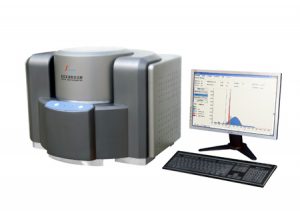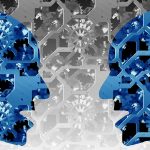GreenTropism, the start-up making matter interact with light
The start-up GreenTropism, specialists in spectroscopy, won an interest-free loan from the Fondation Mines-Télécom last June. It hopes to use this to reinforce its R&D and develop its sales team. Its technology is based on automatic learning and is intended for both industrial and academic use, offering application perspectives ranging from the environment to the IoT.
Is your sweater really cashmere? What is the protein and calorie content of your meal? Perhaps the answers to these questions come from one single field of study: Spectroscopy. Qualifying and quantifying material is at the heart of the mission of GreenTropism, a start-up incubated at Télécom SudParis. To do this, innovators use spectroscopy. “The discipline studies interactions between light and matter”, explains Anthony Boulanger, CEO of GreenTropism. “We all do spectroscopy without even knowing it, because our eyes actually work as spectrometers: they are light-sensitive and send out signals which are then analyzed by our brains. At GreenTropism, we play the role of the brain for classic spectrometers using spectral signatures, algorithms and machine learning.”
The old becoming the new
GreenTropism is based on two techniques implemented in the 1960’s: spectroscopy and machine learning. Getting to grips with the first of these requires an acute knowledge of what a photon is and how it interacts with matter. Depending on the kind of light rays used (i.e. X-rays, ultra-violet, visible, infrared, etc.) the spectral responses are not the same. According to what we are wanting to observe, the nature of a radiation type will be more or less suitable. Therefore, UV rays detect, amongst other things, organic molecules in aromatic cycles, whilst close infrared allows the assessment of water content, for example.
The machine learning element is managed by data scientists working hand in hand with geologists and biochemists from the R&D team at GreenTropism. “It’s important to fully understand the subject we are working on and not to simply process data”, specifies Anthony Boulanger. The start-up has been developing machine learning in the hope of processing several types of spectral data. “Early on, we set up an analysis lab within Irstea. Here, we assess samples with high-resolution spectrometers. This allows us to supplement our database and therefore create our own algorithms. In spectroscopy, there is great variation of data. These come from the environment (wood, compost, waste, water, etc.), from agriculture, from cosmetics, etc. We can study all types of organic matter”, explains the innovator.
GreenTropism’s knowledge goes even further than this. Their deep understanding of infrared, visible and UV radiation, as well as laser beams (LIBS, Raman), allows them to provide a platform for software and agnostic models. This means they are adjustable to various types of radiation and independent to the spectrometer used. Anthony Boulanger adds: “our system allows results to be obtained in real time, whereas traditional analyses in a lab can take several hours over several days.”
[box][one_half]

A miniaturized spectrometer.
[/one_half][one_half_last]

A traditional spectrometer.
[/one_half_last] [/box]
Crédits : Share Alike 2.0 Generic
Real-time analysis technology for all levels of expertise
“Our technology consists in a machine learning platform allowing for the creation of spectrum interpretation models. In other words, it’s software transforming a spectrum into a value which is of interest to a manufacturer that has already mastered spectrometry. This allows them to achieve an operational result since in this way they can control and improve the overall quality of their process”, explains the CEO of GreenTropism. By using a traditional spectrometer in association with the GreenTropism software, a manufacturer can verify the quality of the raw material at the time of its delivery and ensure that its specification is fulfilled for example. Continued analysis also ensures the monitoring of the entire production chain in real time and in a non-destructive way. The result is that all finished products, as well as those in the transformation process, are open to systematic analysis. In this case, the objective is to characterize the material of a product. It is used for example to dissociate materials or two essences of wood. GreenTropism also receives support from partnership with academics such as Irstea or Inrea. These partnerships allow them to extend their fields of expertise, whilst also deepening their understanding of matter.
GreenTropism technology is also aimed at novices wanting to instantly analyze samples. “In this case, we depend on our lab to construct a database in a proactive way, before putting the machine learning platform in place”, adds Anthony Boulanger. It is therefore a question of matter qualification. Obtaining details about the composition of an element such as the nutritional content of a food item is a direct application. “The needs linked to spectroscopy are still vague since we have been processing organic matter. We can measure the widespread parameters such as the level of ripeness of a piece of fruit, as well as other, more concrete details such as the quantity of glucose or saccharine a product contains.”
Towards the democratization of spectroscopy
The fields of application are vast: environment, industry, the list goes on. But GreenTropism technology also adapts to general public usage through the Internet of Things, mass market electrical technology and household electronic items. “The advantage of spectroscopy is that there is no need to create close contact between light and matter. This allows for potential combinations between daily life devices and spectrometers where the user doesn’t have to worry about technical aspects such as calibration for example. Imagine coffee machines that allow you to select the caffeine level in your drink. We could also monitor the health status of our plants through our smartphone”, explains Anthony Boulanger. This last usage would function like a camera. After a flash of light is emitted, the program will receive a spectral response. Rather than receiving a photograph, the user would for example find out the water level in their flower pot.
In order to make these functions possible, GreenTropism is working on the miniaturization of its spectrometers. “Today, spectrometers in labs are 100% reliable. A new, so-called ‘miniaturized’ generation (hand-held) is entering the market. However, these devices lack scientific publication about their reliability, casting doubt on their value. This is why we are working on making this technology reliable at a software level. This is a market which opens up a lot of doors for us, including one which leads to the general public”, Anthony Boulanger concludes.




Leave a Reply
Want to join the discussion?Feel free to contribute!